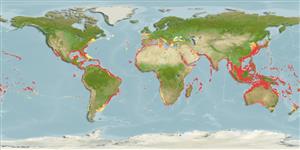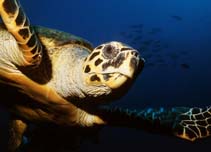Eretmochelys imbricata (Linnaeus, 1766)
Hawksbill turtle| Native range | All suitable habitat | Point map | Year 2050 |

|
| This map was computer-generated and has not yet been reviewed. |
| Eretmochelys imbricata AquaMaps Data sources: GBIF OBIS |
Classification / Names Common names | Synonyms | CoL | ITIS | WoRMS
Not assigned | Testudines | Cheloniidae
Environment: milieu / climate zone / depth range / distribution range Ecology
Reef-associated; brackish; depth range 0 - 300 m (Ref. 102845). Tropical; 50°N - 42°S, 115°W - 130°W (Ref. 1397)
Distribution Countries | FAO areas | Ecosystems | Occurrences | Introductions
Indo-Pacific and the Atlantic Ocean.
Length at first maturity / Size / Weight / Age
Maturity: Lm 50.0 range ? - ? cm Max length : 90.0 cm CL male/unsexed; (Ref. 417); common length : 80.0 cm CL male/unsexed; (Ref. 417); max. published weight: 120.0 kg (Ref. 418)
Short description Morphology
Carapace in adults: cardiform or elliptical; with imbricated dorsal scutes. Head: medium-sized; narrow; with a pointed beak; 2 pairs of prefrontal and 3 or 4 postorbital scales; tomium not serrated on the cutting edge; but hooked at the tip. Snout: narrow; elongated. Carapace scutes: thick for coping with waves; to obtain food from between corals and rocky substrates. Scutes: strongly imbricated at maturity. Scutelation of the carapace: similar to Chelonia, with 5 costal; 4 pairs of lateral (the first not touching the precentral scute); 11 pairs of marginal plus one pair of postcentral or pigal scutes. Plastron: covered by 5 pairs of scutes; plus one or two intergular; at times 1 small interanal. There are 4 poreless inframarginal scutes covering each bridge. Each rear and fore flipper bears 2 claws on its anterior border. Males: stronger, more curved claws and longer tails than females. Hatchlings and juveniles: wider carapace than adults. Carapace have 3 keels of spines which disappear with growth. Young adults: sometimes have a remnant of the dorsal central keel; without spines. In juveniles and subadults: scutes of the carapace are indented on the rear third of the carapace margin. Color: most colorful among sea turtles. In Eastern Pacific, pattern shows from very bright colors to the heavy melanistic forms. Scales of the head: creamy or yellow margins; more apparent at the sides or cheeks than on the roof. Carapace color: in spots or stripes; of the complementary colors: brown; red; black and yellow. Color spots and stripes: arranged in a fan-like pattern. Scutes underneath are thin and amber-colored; in juveniles, brown spots in the rear part of each scute. Head and flippers dorsal side: darker and less variable; in eastern Pacific population, the coloration is sometimes nearly black. Hatchlings: more homogeneous in color. At the rear part of the carapace, mostly brown with paler blotches on the scutes; and, also small pale spots on the 'tip' of each scute along the 2 keels of the plastron.
The most tropical of all sea turtles living in littoral waters. Turtles measuring up to 10 cm straight carapace length are usually nektonic animal. A carnivorous turtle commonly poking in crevices between rocks and corals; it becomes a regular inhabitant of hard substrata, i.e., corals, tunicates, algae and sponges. The duration of incubation lasts 47 to 75 days but varies depending on place and time. It is a high valued species in the international market (Ref. 1397). Most often seen in shallow waters around reefs, bays, and inlets (Ref. 122680). Turtles measuring up to 10 cm straight carapace length are usually nektonic animal. It changes to benthic feeding when it approaches coastal areas. This is a carnivorous turtle commonly poking in crevices between rocks and corals. It feeds on algae, ascidians, sponges, bryozoans, molluscs, hydroids, barnacles, cephalopods, salps, and seagrasses (Ref. 97534). It becomes a regular inhabitant of hard substrata, i.e., corals, tunicates, algae and sponges (Ref. 417). Associated with reef fishes (Ref. 104964) and a shrimp (Ref. 104967).
Life cycle and mating behavior Maturity | Reproduction | Spawning | Eggs | Fecundity | Larvae
Commonly received attention from several males, polygamy. It has been observed that male holds the female by using its claws and tail while mating at shallow areas lasting for several hours. This species is considered to be a solitary nester which is confined between 25°N and 35°S. Nesting occurs mostly toward the end of spring throughout the summer with a nesting cycle of 2 or 3 years with a mean of 2.6 years. Renesting intervals lasts for 2 to 3 weeks with an average number of 2.3 clutches per season. The duration of incubation lasts 47 to 75 days but varies depending on place and time. Generally, hatchlings emerge when sand is below 28°C during the first hours of the night. They find their way rapidly to the surf zone and disappear for some time until they reach their age when they are mature enough to nest (Ref. 1397). Temperature-dependent Sex Determination (TSD) is demonstrated in this species (Refs. 83975, 83972, 83977). DNA samples from females and their offspring show that the number and which breeding males are involved can be identified. Female turtles mate at the beginning of the season, probably before migrating to nesting beaches and the sperm is stored for usage over the next couple of months. Each female mates with a different male showing that the their population is genetically viable (Ref. 92951).
Main reference
References | Coordinator | Collaborators
Hirth, H.F. 1993. (Ref. 97534)
IUCN Red List Status (Ref. 130435)
Critically Endangered (CR) (A2bd); Date assessed: 30 June 2008
CITES status (Ref. 108899)
Appendix I: International trade banned
CMS (Ref. 116361)
Appendix I & II: Endangered migratory species conserved through agreements
Threat to humans
Human uses
Fisheries: highly commercial
FAO - Fisheries: landings, species profile | FishSource | Sea Around Us
Tools
More information
Internet sources
BHL | BOLD Systems | CISTI | DiscoverLife | FAO(Fisheries: species profile; publication : search) | Fishipedia | GenBank (genome, nucleotide) | GloBI | Gomexsi | Google Books | Google Scholar | Google | PubMed | Tree of Life | Wikipedia (Go, Search) | Zoological Record
Estimates based on models
Preferred temperature
(Ref. 115969): 20.7 - 29, mean 27.2 (based on 5592 cells).
Resilience
(Ref. 69278):
Low, minimum population doubling time 4.5 - 14 years (K=0.09-0.26; tm=3.5).
Price category
(Ref. 80766):
Unknown.



